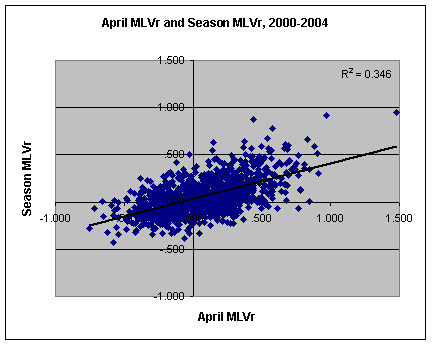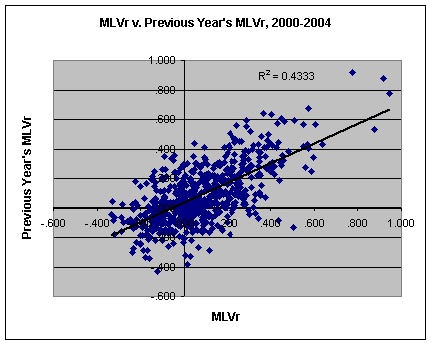BP Comment Quick Links

 | |
April 21, 2005 Crooked NumbersApril Fools
April stats are meaningless. OK, that's not entirely fair. March stats are meaningless, April stats are just misleading. As Joe Sheehan pointed out yesterday, most everyone knows this and understands it, but when you love talking about baseball, no one wants to say "let's wait until July." Instead, we qualify all our statements before launching into discussions of Brian Roberts' home run chase, Tim Hudson's hard luck, and Edgardo Alfonzo chasing .400. As an exercise in restraint, here are the Best and Worst hitters on April 30, 2004 as ranked by MLVr (min 50 PAs in April and 300 on the year): Batter Year AVG OBP SLG MLVR Barry Bonds 2004 .472 .696 1.132 1.481 Charles Johnson 2004 .333 .458 .875 .848 Lew Ford 2004 .419 .471 .710 .784 Adam Dunn 2004 .328 .538 .750 .767 Sean Casey 2004 .414 .458 .667 .698 Jim Thome 2004 .364 .456 .714 .682 Moises Alou 2004 .361 .400 .735 .645 Manny Ramirez 2004 .388 .448 .647 .617 Laynce Nix 2004 .365 .397 .714 .617 Ron Belliard 2004 .417 .500 .548 .582 ------------ Neifi Perez 2004 .220 .260 .275 -.371 Gabe Kapler 2004 .233 .270 .250 -.380 A.J. Pierzynski 2004 .236 .267 .250 -.385 Luis Rivas 2004 .190 .227 .317 -.391 Tike Redman 2004 .226 .229 .301 -.391 Jimmy Rollins 2004 .183 .263 .268 -.392 Ty Wigginton 2004 .188 .216 .333 -.394 Alex Gonzalez 2004 .182 .222 .312 -.413 Jason Phillips 2004 .162 .275 .221 -.435 Derek Jeter 2004 .168 .255 .232 -.460 While Barry Bonds had already established his dominance, there are quite a few names (Charles Johnson, Laynce Nix, Derek Jeter, Jimmy Rollins) who did not finish the year anywhere near where they began. Similarly, on the morning of May 1 last year, the Red Sox were 15-6, the Orioles 12-9, and the Yanks 12-11. Texas was leading the AL West and the Cardinals were 12-11, a game and a half behind the Astros and Cubs, tied for the division lead at 13-9. Though there are always a few outliers every April, simply dismissing the first month of the season is obviously not the way to go. Games in April count as much as games in September, it's just that the ones in September have greater implications because the likelihood of various outcomes is vastly different. Much like leverage as it pertains to relievers, games later in the season have an apparently larger bearing on the standings. But a slow April, much like a starter who gets shelled in the early innings, can make those late games meaningless. Similarly with individual player statistics, we can estimate just how meaningful that first month is. There are a couple different ways to do this. The first is to use something called confidence intervals for population proportions (referred to as "p-hat" because the symbol is a "p" with a"^" over it). P-hat allows us to determine how accurate our data is with varying degrees of confidence and ranges. Essentially, based on the sample size, the normal distribution curve, and the value in question, p-hat provides a quick formula to provide a range under which the "true" value lies. The best way to think of p-hat is like a coin. We "know" the coin will land on heads 50% of the time if we flipped it forever, but if we only flip it five times, obviously it's not going to come up at 50%. As the number of flips increase, the more information we have about the coin and the closer the total proportion of heads flips will be to 50%. There's a normal curve of outcome distributions with 50% being the most likely (in the middle of the curve) and higher and lower proportions of heads less likely (the tails). Selecting a certain percentage of the area under the curve gives us that much confidence that the "true" likelihood of a heads flip will come up. Using p-hat, we can estimate the minimum and maximum values we need in order to cover the area of the true likelihood. The more times we flip the coin, the tighter the curve gets, and thus the closer the minimum and maximum values get to the mean for a particular confidence level. Getting back to ballplayers, in 2004, Bonds had an OBP of .696 over his first 92 PAs of the season. Using p-hat, we can say that there is a 95% chance that Bonds' "true" OBP is between .602 and .790. If we want to scale back to an 80% confidence interval, the boundaries are .635 and .757. While Bonds finished the 2004 season with a .609 OBP--within the 95% range but outside 80%--over the larger set of all ballplayers, p-hat is very accurate. Unfortunately, there are two problems with employing p-hat to the data above. The first is that p-hat is used with binomial variables, so something like OBP or AVG works well since it's dealing with a simple question of yes/no: hit/no hit; on-base/not on-base. SLG and MLVr, however, are not simple binomials and thus we can't use p-hat for them. Secondly, even after the season is over, the confidence intervals using p-hat are very large. This is because a 162-game season isn't nearly long enough to confidently determine a player's "true" ability. Keith Woolner discussed this with regards to teams a few weeks ago, but the same goes for players. A total of 600-700 plate appearances is a lot, but based on confidence intervals, even with a sample size that large, the 95% confidence range is typically between 90 and 100 points of OBP. Looking at everyone who had an OBP of .350 in 2004, that means that one out of every 20 of them had a "true" OBP of over .390 or under .310. Given a larger sample size--over a career--they'll likely regress towards their "true" OBP. Thus, comparing confidence ranges based on April stats to confidence ranges based on full-season stats gets us into large areas of overlap as well as some rather complicated confidence measurements of the results. Instead, in an effort to keep things a little simpler, let's see how the actual April stats compare to the full-season results. Looking again at the list above, some of those names are right where we'd expect them. Bonds is on top, joined by Adam Dunn, Jim Thome, and Manny Ramirez. Aside from Jeter on the bottom, most of those players are some of the lightest hitters in baseball: Neifi Perez, Luis Rivas, and occasional #3 hitter Tike Redman. Far from being worthless, stats in April are more often than not a good indicator of the season to come. Getting back to the sample group of all players registering at least 50 PA in April and 300 PA on the season, here's how well correlated the stats are. In essence, how well April numbers predict the rest of the season for 2000-2004:  Using April stats from that season, the coefficient of correlation (r-squared) is .346, meaning that the April stats explain about 34.6% of the variance in MLVr. Given that they comprise about 16.7% of the season total, that's not very impressive. Contrast that with the previous season's MLVr:  That's not that much better, but notice both the change in scale (as April MLVr has a much wider range) and slope, indicating that there isn't nearly as much regression to the mean from season to season as from April to the end of the year. Looking at the previous year's MLVr reveals that we're not dealing with a case where April stats pale in comparison to other simple predictive measures. Running the two together as a multivariable regression, r-squared rises to .5595 with the previous season's MLVr about twice as valuable as April's MLVr. So where does all this leave us? For starters, April stats are not meaningless, but rather there are a few outliers every season that draw a lot of attention. On the other hand, those outliers cannot simply be written off as a hot streak or cold streak. Instead, when combined with the previous season's stats or other projections, they can give an early indication about the expected performance of players this season. Averaging two helpings of last year's MLVr and April's MLVr will get you most of the way to an estimate of how a player is going to perform over the course of the season. The other lesson is that only 95% of players will fall into those large confidence areas mentioned above. While it's difficult to generate them for MLVr, of the top 20 players in AVG or OBP at the end of April, it's a good bet that one of them will finish more than 90 points of OBP or 80 points of batting average above or below their current pace. Will it be Roberts? Clint Barmes? Jacque Jones? We'll have to watch to find out.
|